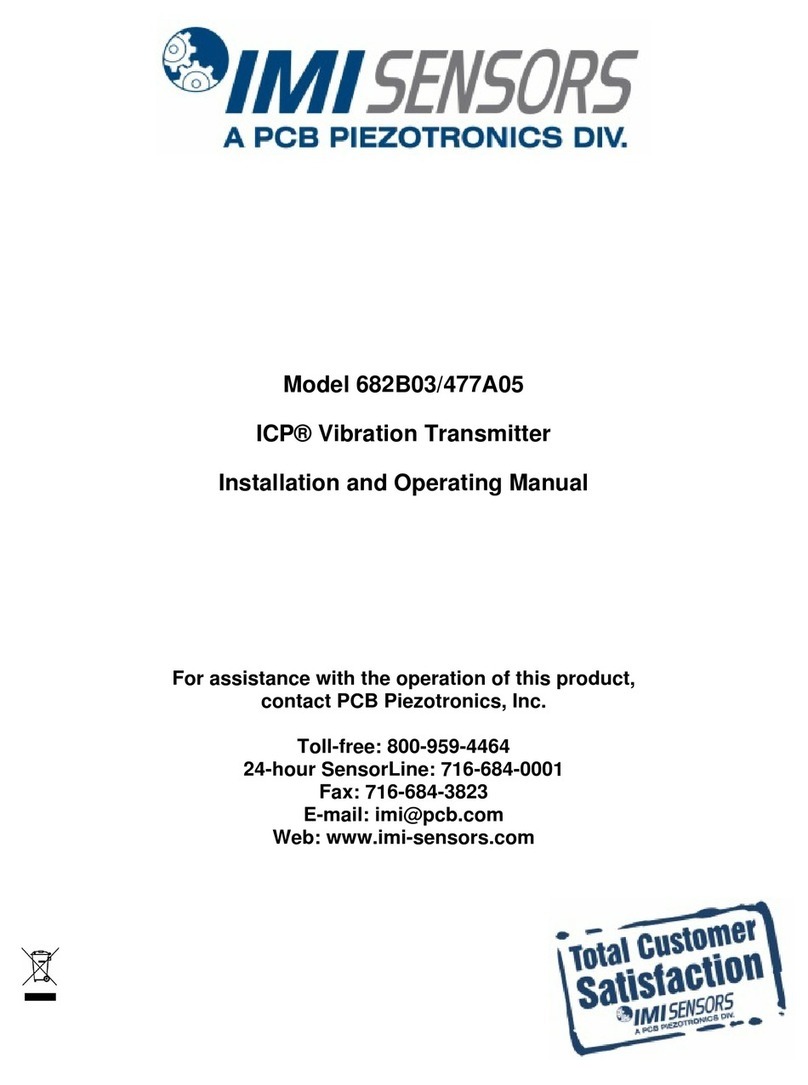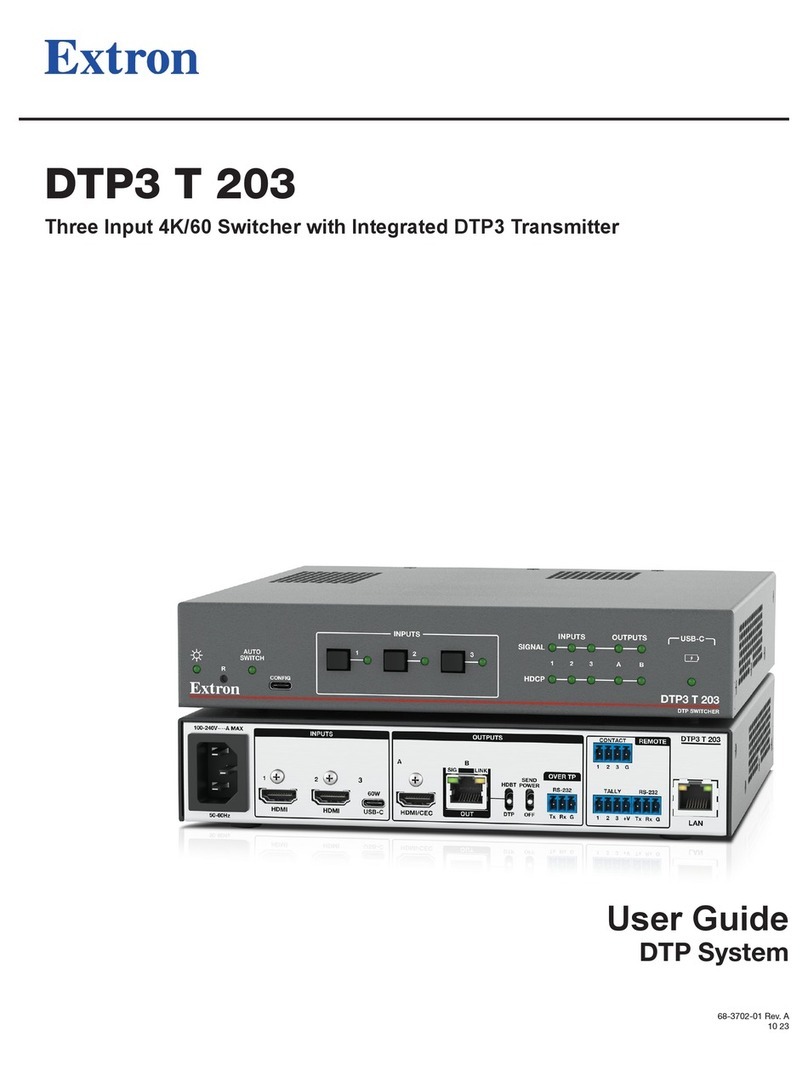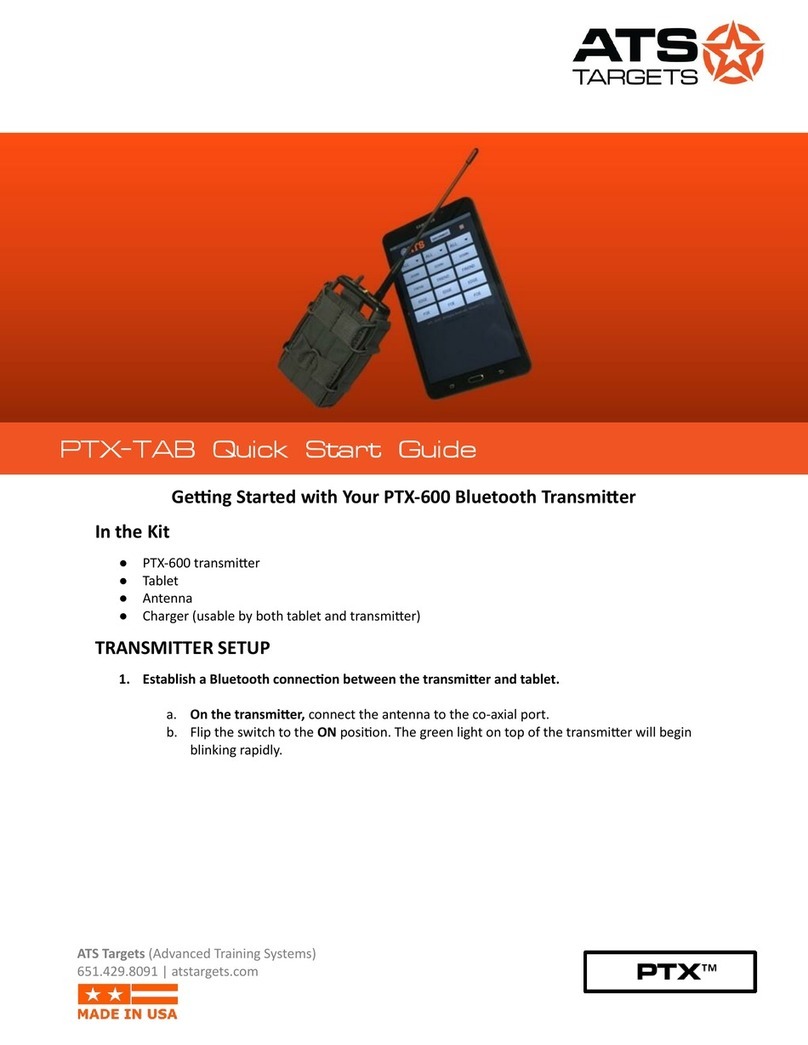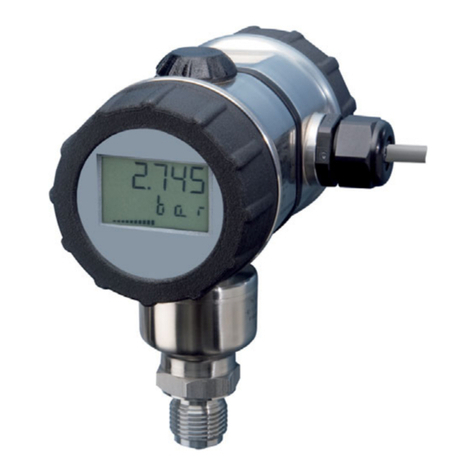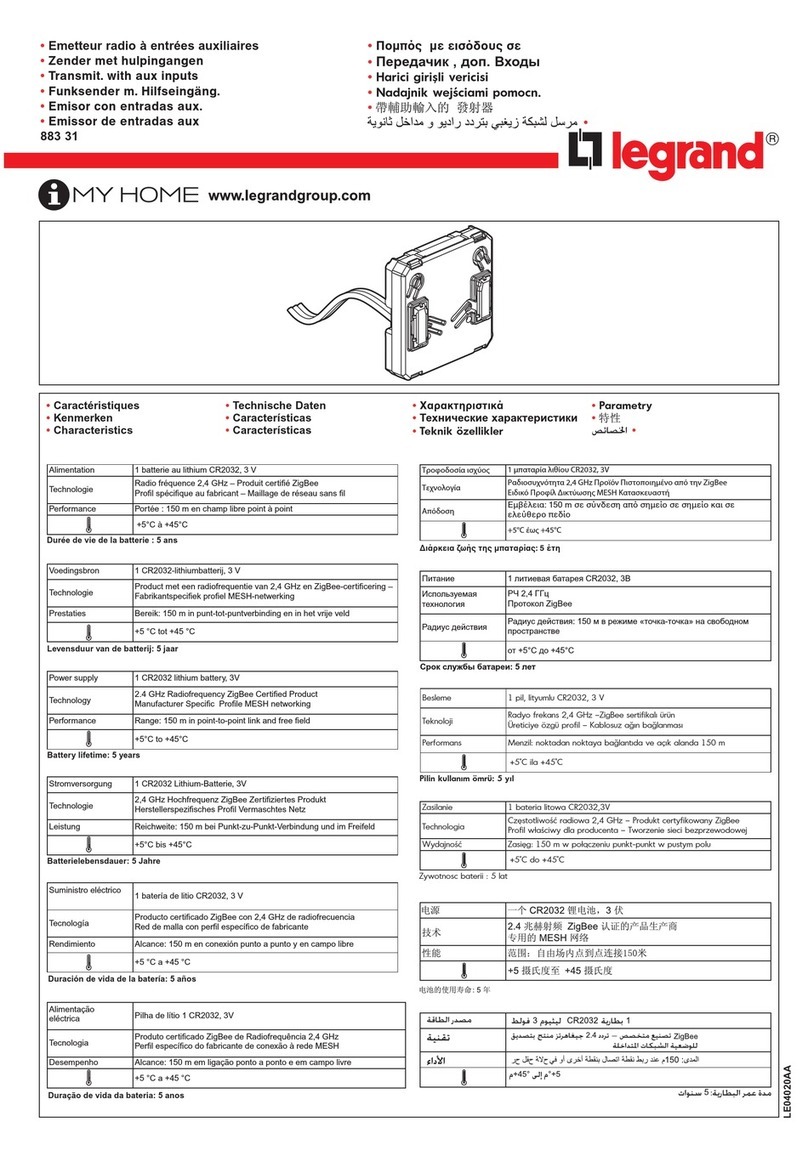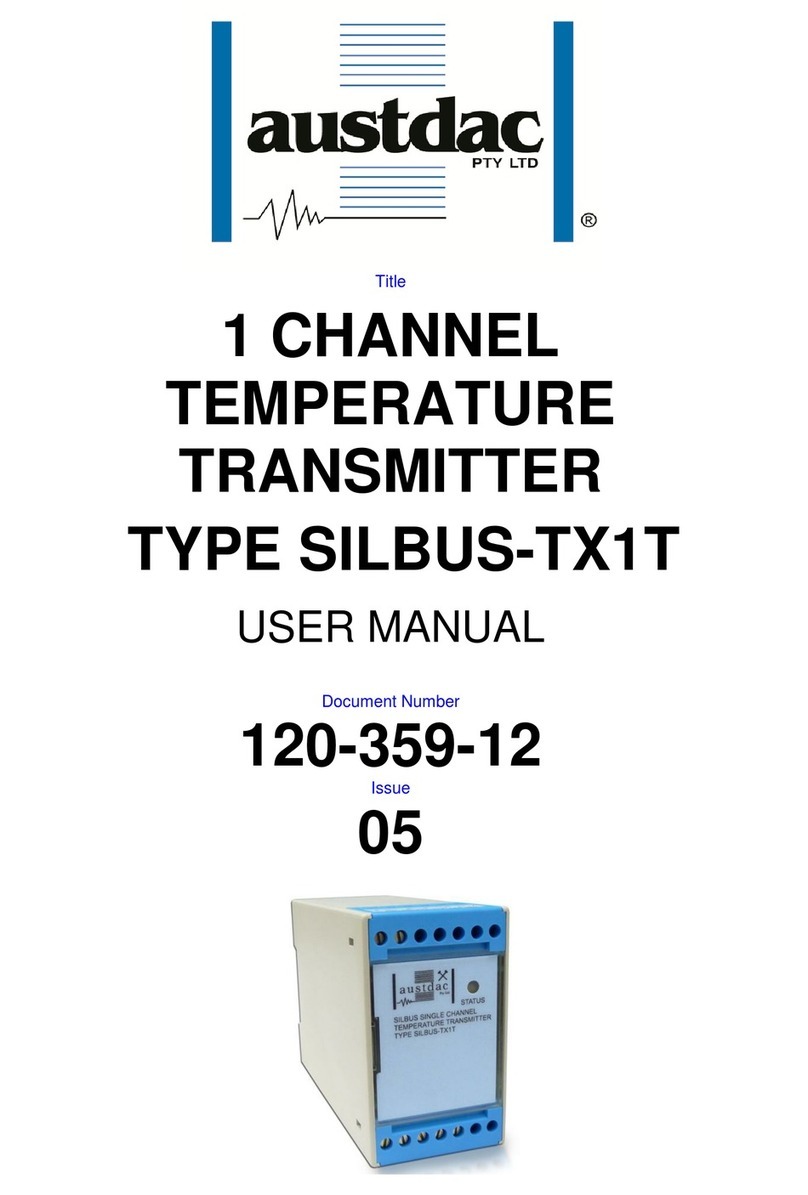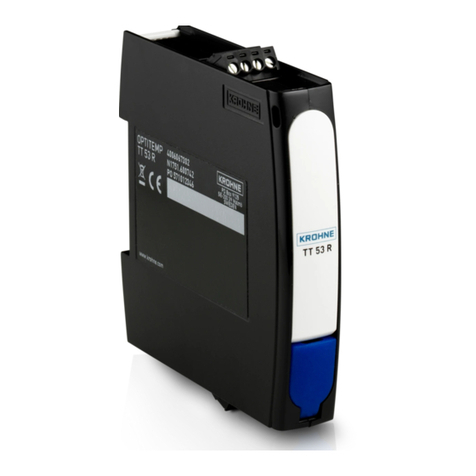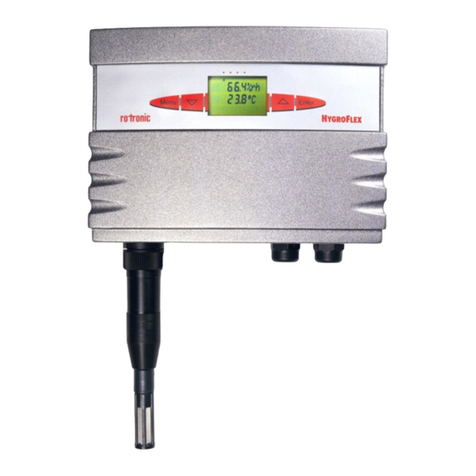IMI SENSORS HT640B01 User manual

Model HT640B01
High Temperature 4-20 mA Velocity Transmitter
Installation and Operating Manual
For assistance with the operation of this product,
contact PCB Piezotronics, Inc.
Toll-free: 800-959-4464
24-hour SensorLine: 716-684-0001
Fax: 716-684-3823
E-mail: [email protected]
Web: www.imi-sensors.com

The information contained in this document supersedes all similar information that
may be found elsewhere in this manual.
Service –Due to the sophisticated
nature of the sensors and associated
instrumentation provided by PCB
Piezotronics, user servicing or repair is
not recommended and, if attempted,
may void the factory warranty. Routine
maintenance, such as the cleaning of
electrical connectors, housings, and
mounting surfaces with solutions and
techniques that will not harm the
physical material of construction, is
acceptable. Caution should be observed
to ensure that liquids are not permitted
to migrate into devices that are not
hermetically sealed. Such devices
should only be wiped with a dampened
cloth and never submerged or have
liquids poured upon them.
Repair –In the event that equipment
becomes damaged or ceases to
operate, arrangements should be made
to return the equipment to PCB
Piezotronics for repair. User servicing or
repair is not recommended and, if
attempted, may void the factory
warranty.
Calibration –Routine calibration of
sensors and associated instrumentation
is recommended as this helps build
confidence in measurement accuracy
and acquired data. Equipment
calibration cycles are typically
established by the users own quality
regimen. When in doubt about a
calibration cycle, a good “rule of thumb”
is to recalibrate on an annual basis. It is
also good practice to recalibrate after
exposure to any severe temperature
extreme, shock, load, or other
environmental influence, or prior to any
critical test.
PCB Piezotronics maintains an ISO-
9001 certified metrology laboratory and
offers calibration services, which are
accredited by A2LA to ISO/IEC 17025,
with full traceability to SI through
N.I.S.T. In addition to the normally
supplied calibration, special testing is
also available, such as: sensitivity at
elevated or cryogenic temperatures,
phase response, extended high or low
frequency response, extended range,
leak testing, hydrostatic pressure
testing, and others. For information on
standard recalibration services or
special testing, contact your local PCB
Piezotronics distributor, sales
representative, or factory customer
service representative.
Returning Equipment –Following
these procedures will ensure that your
returned materials are handled in the
most expedient manner. Before
returning any equipment to PCB
Piezotronics, contact your local
distributor, sales representative, or
factory customer service representative
to obtain a Return Warranty, Service,
Repair, and Return Policies and
Instructions Materials Authorization
(RMA) Number. This RMA number
should be clearly marked on the outside
of all package(s) and on the packing
Service, Repair, and Return
Policies and Instructions

list(s) accompanying the shipment. A
detailed account of the nature of the
problem(s) being experienced with the
equipment should also be included
inside the package(s) containing any
returned materials.
A Purchase Order, included with the
returned materials, will expedite the
turn-around of serviced equipment. It is
recommended to include authorization
on the Purchase Order for PCB to
proceed with any repairs, as long as
they do not exceed 50% of the
replacement cost of the returned
item(s). PCB will provide a price
quotation or replacement
recommendation for any item whose
repair costs would exceed 50% of
replacement cost, or any item that is not
economically feasible to repair. For
routine calibration services, the
Purchase Order should include
authorization to proceed and return at
current pricing, which can be obtained
from a factory customer service
representative.
Contact Information –International
customers should direct all inquiries to
their local distributor or sales office. A
complete list of distributors and offices
can be found at www.pcb.com.
Customers within the United States may
contact their local sales representative
or a factory customer service
representative. A complete list of sales
representatives can be found at
www.pcb.com. Toll-free telephone
numbers for a factory customer service
representative, in the division
responsible for this product, can be
found on the title page at the front of this
manual. Our ship to address and
general contact numbers are:
PCB Piezotronics, Inc.
3425 Walden Ave.
Depew, NY14043 USA
Toll-free: (800) 828-8840
24-hour SensorLineSM: (716) 684-0001
Website: www.pcb.com

PCB工业监视和测量设备 - 中国RoHS2公布表
PCB Industrial Monitoring and Measuring Equipment - China RoHS 2 Disclosure Table
部件名称
有害物质
铅(Pb)
汞
(Hg)
镉
(Cd)
六价铬(Cr(VI))
多溴联苯 (PBB)
多溴二苯醚(PBDE)
住房
O
O
O
O
O
O
PCB板
X
O
O
O
O
O
电气连接器
O
O
O
O
O
O
压电晶体
X
O
O
O
O
O
环氧
O
O
O
O
O
O
铁氟龙
O
O
O
O
O
O
电子
O
O
O
O
O
O
厚膜基板
O
O
X
O
O
O
电线
O
O
O
O
O
O
电缆
X
O
O
O
O
O
塑料
O
O
O
O
O
O
焊接
X
O
O
O
O
O
铜合金/黄铜
X
O
O
O
O
O
本表格依据 SJ/T 11364 的规定编制。
O:表示该有害物质在该部件所有均质材料中的含量均在 GB/T 26572 规定的限量要求以下。
X:表示该有害物质至少在该部件的某一均质材料中的含量超出 GB/T 26572 规定的限量要求。
铅是欧洲RoHS指令2011/65/ EU附件三和附件四目前由于允许的豁免。
CHINA RoHS COMPLIANCE

DOCUMENT NUMBER: 21354
DOCUMENT REVISION: D
ECN: 46162
Component Name
Hazardous Substances
Lead
(Pb)
Mercury
(Hg)
Cadmium
(Cd)
Chromium VI
Compounds
(Cr(VI))
Polybrominated
Biphenyls
(PBB)
Polybrominated
Diphenyl
Ethers (PBDE)
Housing
O
O
O
O
O
O
PCB Board
X
O
O
O
O
O
Electrical
Connectors
O
O
O
O
O
O
Piezoelectric
Crystals
X
O
O
O
O
O
Epoxy
O
O
O
O
O
O
Teflon
O
O
O
O
O
O
Electronics
O
O
O
O
O
O
Thick Film
Substrate
O
O
X
O
O
O
Wires
O
O
O
O
O
O
Cables
X
O
O
O
O
O
Plastic
O
O
O
O
O
O
Solder
X
O
O
O
O
O
Copper Alloy/Brass
X
O
O
O
O
O
This table is prepared in accordance with the provisions of SJ/T 11364.
O: Indicates that said hazardous substance contained in all of the homogeneous materials for this part is below the limit
requirement of GB/T 26572.
X: Indicates that said hazardous substance contained in at least one of the homogeneous materials for this part is above
the limit requirement of GB/T 26572.
Lead is present due to allowed exemption in Annex III or Annex IV of the European RoHS Directive 2011/65/EU.

SENSORS
Model HT 640/641/645/646 B Series High Temperature 4-20mA SensorModel HT 640/641/645/646 B Series High Temperature 4-20mA Sensor
Operating Guide with Enclosed Warranty Information
3425 Walden Avenue, Depew, New York 14043-2495
Phone (716) 684-0003
Fax (716) 684-3823
Toll Free Line 1-800-959-4IMI
AND INSTRUMENTATION FOR MACHINE CONDITION MONITORINGAND INSTRUMENTATION FOR MACHINE CONDITION MONITORING
MANUAL NUMBER: 31330
MANUAL REVISION: NR
ECN NUMBER:

SENSORS A
Table of Contents
ND INSTRUMENTATION FOR MACHINE CONDITION MONITORING
Introduction...................................................................................................................... Page 3
General Features
Dimension Drawing......................................................................................................... Page 4
Operation and Wiring ...................................................................................................... Page 5
Standard Wiring
Taking Measurements
RV Option
TO Option
Installation....................................................................................................................... Page 9
Direct Adhesive Mount
Standard Stud Mount
Adhesive Stud Mount
Magnetic Mount
ESD Sensitivity............................................................................................................... Page 13
Warranty/Servicing
Warranty, Service & Return Procedure .......................................................................... Page 14
Customer Service........................................................................................................... Page 15
PAGE 2

SENSORS A
Introduction
ND INSTRUMENTATION FOR MACHINE CONDITION MONITORING
The Model HT 640/641/645/646 B Series High Temperature 4-20mA Sensors combine the capabilities of a
piezoelectric vibration sensor and a 4-20mA vibration transmitter. The sensor outputs a 4-20mA signal that is
proportional to the overall velocity or acceleration of the machinery. Ideal for monitoring the vibration of process
equipment such as fans, motors and pumps, the output of the sensor is used for process control or predictive
maintenance. There are many options in this series. Please refer to specific specification sheets for further
details.
General Features
• Expanded Temperature Range from –40°C to +125°C
• Imbedded Piezoelectric Accelerometer for improved accuracy and frequency response.
• Vibration range can be in Acceleration or Velocity.
• Allows for continuous vibration monitoring of critical applications.
• Reduces sophisticated vibration analysis requirements.
• RV (Raw Vibration) option for conducting frequency analysis and machinery diagnostics.
• TO (Temperature Output) option via an independent 4-20mA loop.
• Readily interfaces to existing process control and predictive maintenance equipment.
• Rugged stainless steel construction for applications in harsh environments.
• Flexible design allows for various custom requirements.
PAGE 3

SENSORS A
Dimension Drawing
ND INSTRUMENTATION FOR MACHINE CONDITION MONITORING
Inch (mm)
PAGE 4

SENSORS A
Operation and Wiring
ND INSTRUMENTATION FOR MACHINE CONDITION MONITORING
Standard Wiring
The Model 640/641/645/646 B Series operates from a standard 2-wire, 4-20mA loop. If using a loop powered
unit, attach the positive (+) input from the power supply to Pin A or Red wire on the sensor and the negative (-)
input from the power supply to Pin B or Blue wire of the sensor.
Figure 1 – wiring: loop powered Figure 2 – wiring: loop powered/DC source
If using a standard DC power supply, install either an ammeter and/or load resistor in line with the output, Pin B or
Blue wire.
The resistor will generate a DC voltage that is proportional to current by:
V
I
R
=
If R ohmsand I mA thenV VDC=
=
=500 6 3,
Note:
- Resistor value must be less than: (Vsupply – 12) x 50.
- For integral cable sensors: RED wire is positive, BLUE wire is negative.
PAGE 5

SENSORS A
Taking Measurements
ND INSTRUMENTATION FOR MACHINE CONDITION MONITORING
When measuring the current output from the unit, use the following formula to calculate the vibration level:
Vibration Output = (Measured Output – 4mA) x (Full Scale Vibration Output /16mA)
Measured mA 640BX0 640BX1 640BX2
4.00 0.0 ips, pk 0.0 ips, pk 0.0 ips, pk
8.00 0.125 ips, pk 0.25 ips, pk 0.5 ips, pk
12.0 0.25 ips, pk 0.5 ips, pk 1.0 ips, pk
15.75 0.37 ips, pk 0.73 ips, pk 1.47 ips, pk
20 0.5 ips, pk 1.0 ips, pk 2.0 ips, pk
Measured mA 641BX0 641BX1 641BX2
4.00 0.0 ips, rms 0.0 ips, rms 0.0 ips, rms
8.00 0.125 ips, rms 0.25 ips, rms 0.5 ips, rms
12.0 0.25 ips, rms 0.5 ips, rms 1.0 ips, rms
15.75 0.37 ips, rms 0.73 ips, rms 1.47 ips, rms
20 0.5 ips, rms 1.0 ips, rms 2.0 ips, rms
Measured mA 645 646
4.00 0.0 g rms 0.0 g rms
8.00 1.25 g rms 2.50 g rms
12.0 2.50 g rms 5.00 g rms
15.75 3.67 g rms 7.34 g rms
20 5.00 g rms 10.0 g rms
PAGE 6

SENSORS AND INSTRUMENTATION FOR MACHINE CONDITION MONITORINGS AND INSTRUMENTATION FOR MACHINE CONDITION MONITORING
RV OptionRV Option
The RV (raw vibration) option includes a 100mV/g ±20% additional output. The accelerometer frequency range is
1 Hz-10 kHz, maximum amplitude of 15 g-pk. Data collectors or analyzers can use this vibration signal for further
analysis.
Figure 3 – RV wiring
For integral cable sensors:
RED 4-20mA Positive
BLACK 4-20mA Negative (same as green)
GREEN -RV Acceleration Negative (same as black)
WHITE +RV Acceleration Positive
Note:
-The Acceleration Signal Negative has to be isolated from any grounding. If this terminal is grounded, the 4-
20mA loop will short, causing no output.
-The acceleration output signal is ideally suited for use with portable battery powered data collectors or analyzers.
PAGE 7

SENSORS A
TO Option
ND INSTRUMENTATION FOR MACHINE CONDITION MONITORING
The TO (Temperature Output) option includes an additional independent 4-20mA output for temperature
measurement. The temperature range is from -40°C to 125°C with an overall accuracy of ±5%FSO. The
imbedded temperature sensor monitors the environment internal to the sensor housing and is situated at
approximately mid level.
Figure 4 – TO wiring
For integral cable sensors:
RED 4-20mA Vibration Positive
BLACK 4-20mA Vibration Negative
GREEN 4-20mA Temperature Negative
WHITE 4-20mA Temperature Positive
Note:
- The same power supply can be used for both4-20mA loops. Connect both positive terminals directly to the
power supply, and then use the negative terminals for independent process loops.
PAGE 8

SENSORS AND INSTRUMENTATION FOR MACHINE CONDITION MONITORINGS AND INSTRUMENTATION FOR MACHINE CONDITION MONITORING
InstallationInstallation
When choosing a mounting method, consider closely the advantages and disadvantages of each technique.
Typical mounting types are stud, direct adhesive, adhesive mounting base and magnetic mounting base. Since
the frequency response is limited to 1 kHz on the 640/641, any of the four methods can be used without seriously
affecting the data values. The mounting method might affect some of the 645/646 series because of the
increased frequency response.
When choosing a mounting method, consider closely the advantages and disadvantages of each technique.
Typical mounting types are stud, direct adhesive, adhesive mounting base and magnetic mounting base. Since
the frequency response is limited to 1 kHz on the 640/641, any of the four methods can be used without seriously
affecting the data values. The mounting method might affect some of the 645/646 series because of the
increased frequency response.
Direct Adhesive Mount ProcedureDirect Adhesive Mount Procedure
For restrictions of space or for convenience, most sensors (with the exception of integral stud models) can be
adhesive-mounted directly to the machine surface.
STEP 1 Prepare a smooth, flat mounting surface. A minimum surface finish of 63 µin [0,00016 mm] generally
works best.
STEP 2 Place a small portion of adhesive on the underside of the sensor. Firmly press down on the top of the
assembly to displace any adhesive. Be aware that excessive amounts of adhesive can make sensor removal
difficult.
Figure 5 – direct adhesive mounting
A
dhesiv
e
Typical
A
cceleromete
r
Firmly Press Dow
n
PAGE 9

SENSORS AND INSTRUMENTATION FOR MACHINE CONDITION MONITORINGS AND INSTRUMENTATION FOR MACHINE CONDITION MONITORING
Standard Stud Mount ProcedureStandard Stud Mount Procedure
This mounting technique requires smooth, flat contact surfaces for proper operation and is recommended for
permanent and/or secure installations. Stud mounting is also recommended when testing at high frequencies.
Note: DO NOT attempt mounting on curved, rough or uneven surfaces, as the potential for misalignment and
limited contact surface may significantly reduce the sensor’s upper operating frequency range.
Figure 6 – mounting surface preparation
1/4-28 Stud 1/4-28 Captive Screw
A (in) 0.250 0.250
B (in) 0.350 0.350
1
.
1
Times
Sensor Diameter
B
A
Torque (ft-lb) 2 to 5 2 to 5
STEP 1 First, prepare a smooth, flat mounting surface, and then drill and tap a mounting hole in the center of this
area as shown in Figure 6. A precision-machined mounting surface with a minimum finish of 63 µin [0,00016 mm]
is recommended. (If it is not possible to properly prepare the machine surface, consider using an adhesive
mounting pad as a possible alternative.) Inspect the area, checking that there are no burrs or other foreign
particles interfering with the contact surface.
STEP 2 Wipe clean the mounting surface and spread on a light film of grease, oil or similar coupling fluid prior to
installation.
Figure 7 – mounting surface lubrication
Adding a coupling fluid improves vibration transmissibility by filling small voids in the mounting surface and
increasing the mounting stiffness. For semi-permanent mounting, substitute epoxy or another type of adhesive.
STEP 3 HAND-tighten the sensor/mounting stud to the machine, then secure the sensor with a torque wrench to
the mounting surface by applying the recommended mounting torque (see enclosed specification data sheet for
proper mounting torque). It is important to use a torque wrench during this step. Under-torquing the sensor
may not adequately couple the device; over-torquing may result in stud failure and possibly permanent
damage.
PAGE 10

SENSORS AND INSTRUMENTATION FOR MACHINE CONDITION MONITORINGS AND INSTRUMENTATION FOR MACHINE CONDITION MONITORING
Adhesive Stud Mount ProcedureAdhesive Stud Mount Procedure
Adhesive mounting is often used for temporary installation or when the machine surface cannot be adequately
prepared for stud mounting. Adhesives like hot glue or wax work well for temporary mounts; two-part epoxies and
quick-bonding gels provide a more permanent mount.
Note:Adhesively mounted sensors often exhibit a reduction in high-frequency range. Generally, smooth
surfaces and stiff adhesives provide the best frequency response. Contact the factory for recommended epoxies.
This method involves attaching a base to the machine surface, then securing the sensor to the base. This allows
for easy removal of the accelerometer.
STEP 1 Prepare a smooth, flat mounting surface. A minimum surface finish of 63 µin [0,00016 mm] generally
works best.
STEP 2 Stud-mount the sensor to the appropriate adhesive mounting base according to the guidelines set forth
in Steps 2 and 3 of the Standard Stud Mount Procedure.
STEP 3 Place a small portion of adhesive on the underside of the mounting base. Firmly press down on the
assembly to displace any extra adhesive remaining under the base.
Figure 8 – mounting base: adhesive installation
Firmly Press Dow
n
Sensor Stud Mount
s
to Top Surface o
f
Mounting Bas
e
Mounting Bas
e
A
dhesiv
e
PAGE 11

SENSORS AND INSTRUMENTATION FOR MACHINE CONDITION MONITORINGS AND INSTRUMENTATION FOR MACHINE CONDITION MONITORING
Magnetic Mount ProcedureMagnetic Mount Procedure
Magnetic mounting provides a convenient means for making portable measurements and is commonly used for
machinery monitoring and other portable or trending applications.
Note: The correct magnet choice and an adequately prepared mounting surface is critical for obtaining reliable
measurements, especially at high frequencies. Poor installations can cause as much as a 50% drop in the sensor
frequency range.
Not every magnet is suitable for all applications. For example, rare earth magnets are commonly used
because of their high strength. Flat magnets work well on smooth, flat surfaces, while dual-rail magnets
are required for curved surfaces. In the case of non-magnetic or rough surfaces, it is recommended that
the user first weld, epoxy or otherwise adhere a steel mounting pad to the test surface. This provides a
smooth and repeatable location for mounting.
Figure 9 – magnet types
Dual-Rail Ma
g
ne
t
Flat Ma
g
ne
t
Sensor Stud Mounts t
o
Top Surface of Ma
g
ne
t
A
LL SURFACES SHOULD BE FLAT AND SMOOTH
Mountin
g
Pad
with Ma
g
ne
t
STEP 1 After choosing the correct magnet type, inspect the unit, verifying that the mounting surfaces are flat and
smooth.
STEP 2 Stud-mount the accelerometer to the appropriate magnet according to the guidelines set forth in Steps 2
and 3 of the Standard Stud Mount Procedure.
STEP 3 Prepare a smooth, flat mounting surface. A minimum surface finish of 63 µin [0,00016 mm] generally
works best. After cleaning the surface and checking for burrs, wipe on a light film of silicone grease, machine oil
or similar-type coupling fluid.
STEP 4 Mount the magnet/sensor assembly to the prepared test surface by gently “rocking” or “sliding” it into
place.
Note: Magnetically mounting accelerometers carelessly has the potential to generate very high (and very
damaging) g levels. To prevent damage, install the assembly gently. If unsure, please contact the factory for
assistance.
PAGE 12

SENSORS AND INSTRUMENTATION FOR MACHINE CONDITION MONITORINGS AND INSTRUMENTATION FOR MACHINE CONDITION MONITORING
Warning 1 – ESD sensitivityWarning 1 – ESD sensitivity
The power supply/signal conditioner should not be opened by anyone other than qualified service
personnel. This product is intended for use by qualified personnel who recognize shock hazards and are familiar
with the safety precautions required to avoid injury.
Warning 2 – ESD sensitivity
This equipment is designed with user safety in mind; however, the protection provided by the equipment may be
impaired if the equipment is used in a manner not specified by PCB Piezotronics, Inc.
Caution 1 – ESD sensitivity
Cables can kill your equipment. High voltage electrostatic discharge (ESD) can damage electrical devices.
Similar to a capacitor, a cable can hold a charge caused by triboelectric transfer, such as that which occurs in the
following:
Laying on and moving across a rug,
Any movement through air,
The action of rolling out a cable, and/or
Contact with a non-grounded person.
The PCB solution for product safety:
Connect the cables only with the AC power off.
Temporarily “short” the end of the cable before attaching it to any signal input or output.
Caution 2 – ESD sensitivity
ESD considerations should be made prior to performing any internal adjustments on the equipment. Any
piece of electronic equipment is vulnerable to ESD when opened for adjustments. Internal adjustments should
therefore be done ONLY at an ESD-safe work area. Many products have ESD protection, but the level of
protection may be exceeded by extremely high voltage.
PAGE 13

SENSORS A
Warranty
ND INSTRUMENTATION FOR MACHINE CONDITION MONITORING
IMI instrumentation is warranted against defective material and workmanship for 1 year unless otherwise
expressly specified. Damage to instruments caused by incorrect power or misapplication, is not covered by
warranty. If there are any questions regarding power, intended application, or general usage, please consult with
your local sales contact or distributor. Batteries and other expendable hardware items are not covered by
warranty.
Service
Because of the sophisticated nature of IMI instrumentation, field repair is typically NOT recommended and may
void any warranty. If factory service is required, return the instrumentation according to the “Return Procedure”
stated below. A repair and/or replacement quotation will be provided prior to servicing at no charge. Before
returning the unit, please consult a factory IMI applications engineer concerning the situation as certain problems
can often be corrected with simple on-site procedures.
Return procedure
To expedite returned instrumentation, contact a factory IMI applications engineer for a RETURN MATERIAL
AUTHORIZATION (RMA) NUMBER. Please have information available such as model and serial number. Also,
to insure efficient service, provide a written description of the symptoms and problems with the equipment to a
local sales representative or distributor, or contact IMI if none are located in your area.
Customers outside the U.S. should consult their local IMI distributor for information on returning equipment. For
exceptions, please contact the International Sales department at IMI to request shipping instructions and an RMA.
For assistance, please call (716) 684-0003, or fax us at (716) 684-3823. You may also receive assistance via e-
PAGE 14

SENSORS AND INSTRUMENTATION FOR MACHINE CONDITION MONITORINGS AND INSTRUMENTATION FOR MACHINE CONDITION MONITORING
Customer ServiceCustomer Service
IMI, a division of PCB Piezotronics, guarantees Total Customer Satisfaction. If, at any time, for any reason, you
are not completely satisfied with any IMI product, IMI will repair, replace, or exchange it at no charge. You may
also choose to have your purchase price refunded.
IMI offers to all customers, at no charge, 24-hour phone support. This service makes product or application
support available to our customers, day or night, seven days a week. When unforeseen problems or emergency
situations arise, call the IMI Hot Line at (716) 684-0003, and an application specialist will assist you.
3425 Walden Avenue, Depew, NY 14043-2495
Phone: (716) 684-0003
•
USA Fax: (716) 684-3823
•
INTL Fax: (716) 684-4703
ICP®is a registered trademark of PCB Group, Incorporated,
which uniquely identifies PCB sensors that incorporate built-in microelectronics.
PAGE 15
Table of contents
Other IMI SENSORS Transmitter manuals
Popular Transmitter manuals by other brands
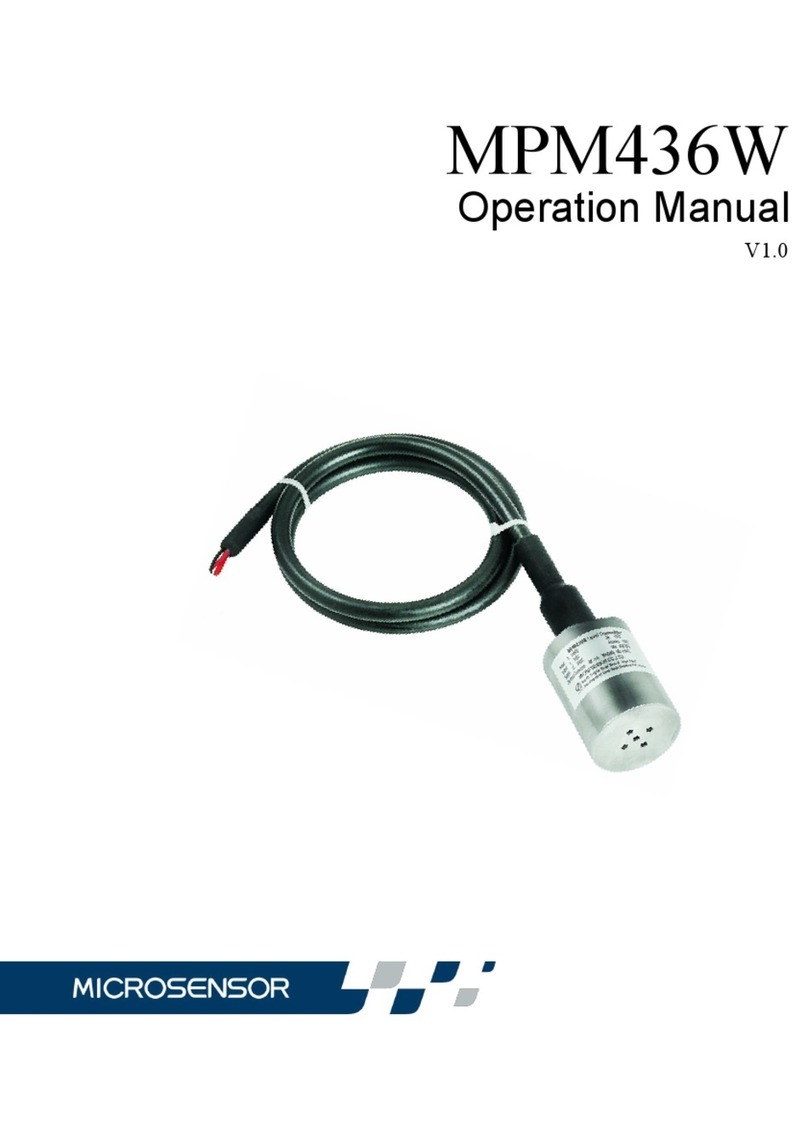
Microsensor
Microsensor MPM436W Operation manual
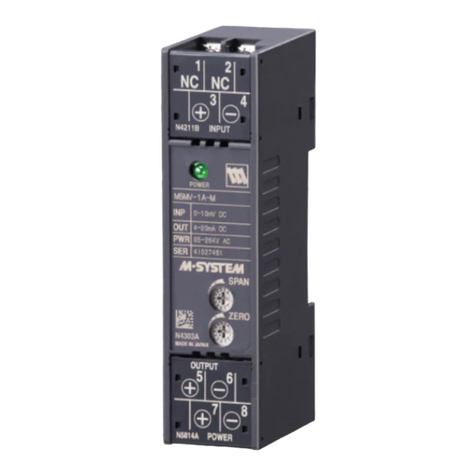
M-system
M-system M5YV instruction manual
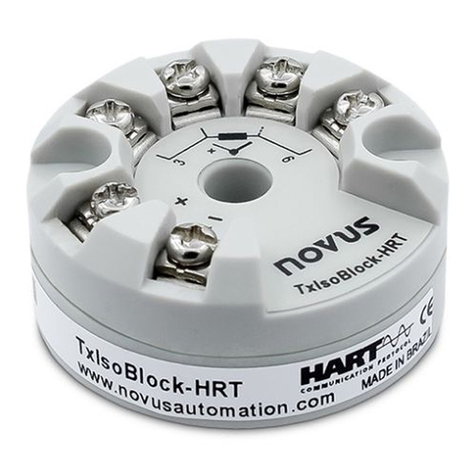
Novus
Novus TxIsoBlock-HRT operating manual
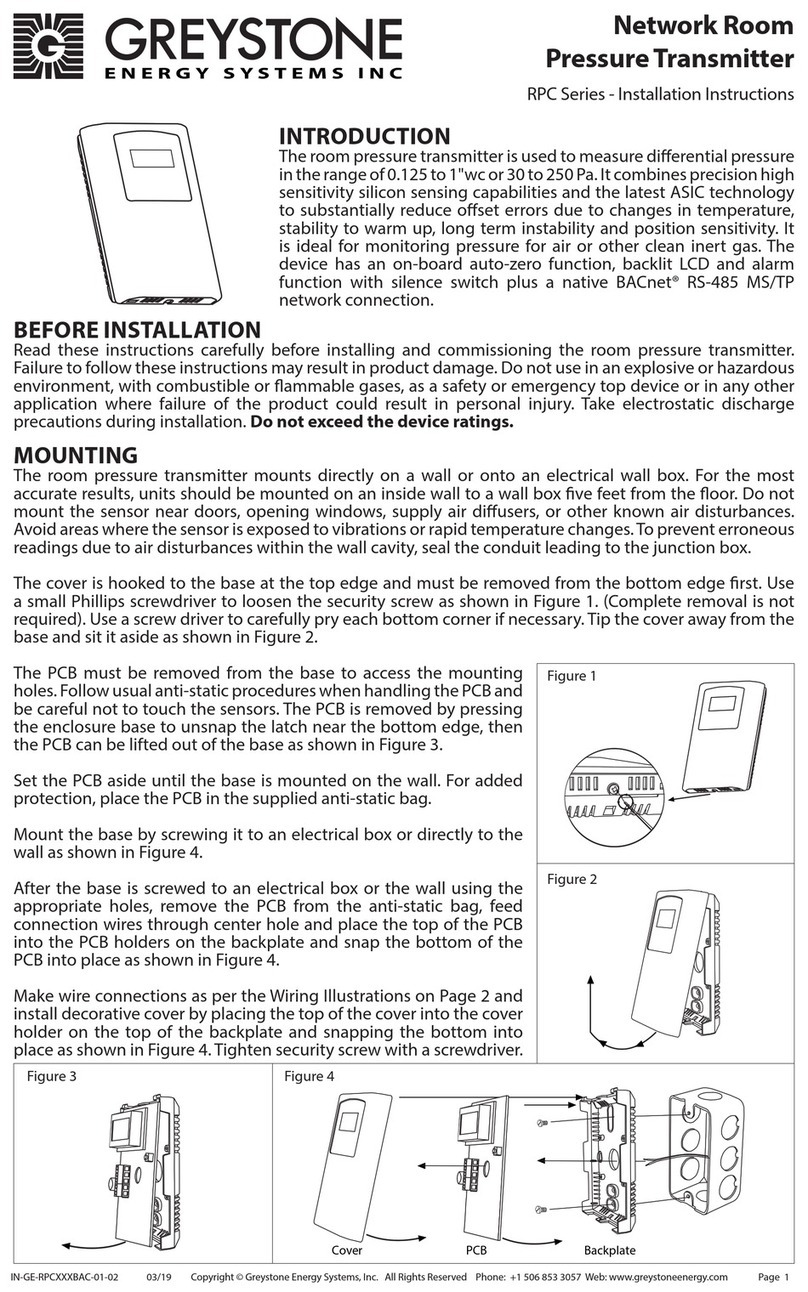
Greystone Energy Systems
Greystone Energy Systems RPC Series installation instructions
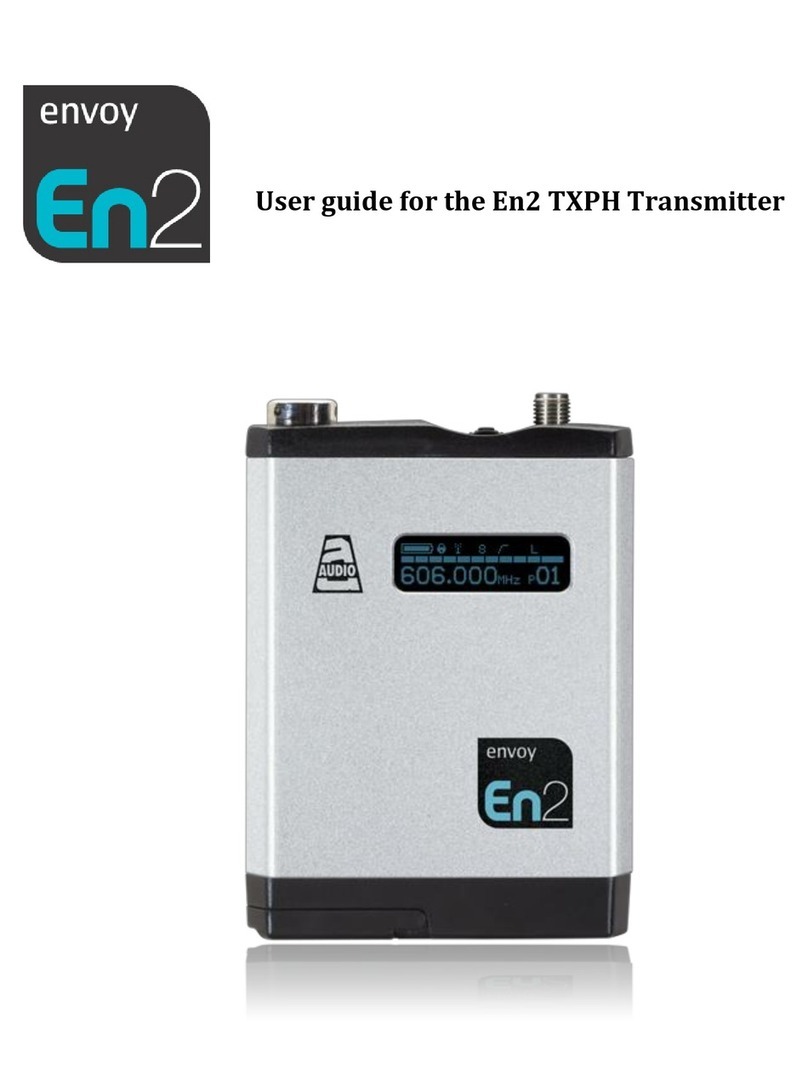
Envoy
Envoy En2 user guide

Vectronic Aerospace
Vectronic Aerospace Drop-Off Release user manual
